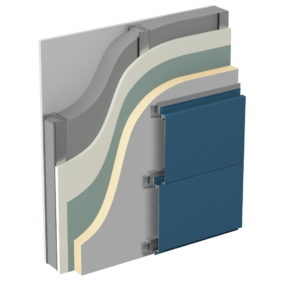This is the first in a multi-part series of articles on the topic of testing and design for exterior wall assemblies that the building codes require to comply with NFPA 285. They are intended to promote effective communication between stakeholders regarding this important fire safety topic for the design and construction of code-compliant exterior wall assemblies.
Introduction
Exterior wall assemblies have become increasingly complex and important elements of the building envelope. Advancements in our understanding of building science, coupled with the need to improve the energy efficiency and resilience of buildings, have led to innovative solutions in both building products and construction methods. Many of the innovative products available to the market today are subject to compliance with prescriptive fire testing and performance requirements as regulated under the International Building Code® (IBC). One of the critical prescribed fire tests for exterior wall assemblies is NFPA® 2851.
Origin of NFPA 285
The roots of today’s NFPA 285 test trace back to work undertaken in the late 1970’s by an Exterior Wall Task Group of the Society for the Plastics Industry (SPI) to develop a test method to evaluate the potential for flame spread of foam plastic insulation when it was installed on exterior walls. The test method was adopted by the Uniform Building Code© (UBC) in 1988 as UBC Standard 17-6, which was later renumbered as UBC 26-4. This original test was based on a very large test specimen (approx. 24-ft tall × 15-ft wide) installed over a two-story test apparatus and exposed to a fire from a 1,285-pound wood crib burning in the first floor room. Due to its sized and scale, this test could only be performed outdoors.
In the 1990s, additional work was performed under the SPI to develop a reduced-scale version (i.e., “intermediate-scale”) of
the UBC 26-4 that retained the two-story configuration, used gas-fired burners to provide the same fire exposure as the original test, and could be performed indoors This reduced-scale test was adopted by the UBC in 1997 as UBC Standard 26-9. The following year, in 1998, the National Fire Protection Association (NFPA) promulgated the NFPA 285 test method based on the technical details of UBC 26-9 with some editorial changes.

In 2000, the three legacy model building codes2 consolidated under the International Code Council (ICC), resulting in the inaugural 2000 Edition of the International Building Code® (IBC). This first issuance of the IBC carried forward provisions requiring exterior wall assemblies of Types I through IV construction containing foam plastic insulation to be tested in accordance with, and meet the acceptance criteria of either, NFPA 285 (previously UBC 26-9) or UBC 26-4. Subsequent editions of the IBC reference only NFPA 285 and have extended its use to regulate other combustible materials and cladding systems (i.e., water-resistive barriers, Metal Composite Material, High-Pressure Decorative Exterior Grade Compact Laminate, fiber reinforced plastic veneers, etc.) in or on exterior walls of Type I through IV construction.
The Test
NFPA 285 is an assembly test, not a component test. It evaluates the performance of a complete exterior wall assembly as a system. This concept of system performance is very important to remember because it is not only the fire performance of each specific material, but also how they interact and are influenced by the configuration geometry, (e.g., air spaces between layers, window header configuration), that combine to produce the observed performance. Test results are Pass / Fail and specific to the tested assembly. The test is designed to evaluate an exterior wall assembly’s ability to resist fire propagation in the following ways:

1. Over the exterior face of the wall assembly.
2. Vertically within the wall assembly cross-section (combustible core, combustible components, air cavities, etc.).
3. Vertically over the interior surface of the wall assembly to the next story above.
4. Laterally from the compartment of origin to adjacent compartments.
Each tested wall assembly is highly instrumented. Test specimens are instrumented in a manner that breaks up the wall assembly into multiple layers; for example, exterior layer, air-gap layer, continuous insulation layer, and stud-cavity insulation layer. Each assembly layer contains approximately 20 thermocouples (TCs).
Depending on the specific composition and configuration, a test specimen may contain 66, 80, or even more TCs. Each TC records temperature data throughout the 30-minute test that, collectively, provides knowledgeable persons with information about the three-dimensional movement (vertically, horizontally, and through) of heat and flame in the assembly during the test. Acceptance criteria determining the Pass/Fail result are a combination of temperature limitations, temperature-rise limitations, and visual observations at certain locations in the specimen and the second-story room of the test apparatus.
Recent editions of NFPA 285 have seen several revisions to requirements for test specimen design and reporting as well as explanatory and guidance information. For example, the current 2023 Edition contains a new Annex B3 with guidance for extending successful test data to wall assemblies that are similar to the tested wall assembly. The 2019 Edition contained several technical revisions that included:
- Requirements for test specimens to have at least one horizontal and one vertical joint/seam of the exterior veneer within a defined area above the window opening.
- A new prescribed procedure and materials to generically close the window head, jambs and sill as well as the option to use a specific closure/construction detail(s) per the manufacturer’s instructions.
- Requirements for the test report to contain drawings and a description of the construction details around the window.
The next issue of this series will discuss how the results of NFPA 285 tests provide subject matter experts with a great deal of dynamic performance information for analysis toward extending test results to alternative assembly configurations.
1 NFPA® 285 Standard Fire Test Method for Evaluation of Fire Propagation Characteristics of Exterior Wall Assemblies Containing Combustible Components
2 BOCA National Building Code (BOCA/NBC) by the Building Officials Code Administrators International (BOCA); Uniform Building Code (UBC) by the International Conference of Building Officials (ICBO); and Standard Building Code (SBC) by the Southern Building Code Congress International (SBCCI)
3 NFPA 285, 2023 Edition, Annex B – Guide for Extensions of Results from Assemblies that Meet NFPA 285

